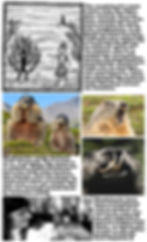How Much Wood Can a Woodchuck Chuck?
- Notes From The Frontier
- Apr 30, 2020
- 3 min read

This child’s tongue-twister has probably helped to make the unassuming and laid-back woodchuck famous. But, as the riddle later infers—“IF a woodchuck could chuck wood?”— the fat furry rodent cannot really chuck wood. He got his misnamed misnomer from the Algonquian word, “wuchak,” meaning digger. But the early Colonists twisted the name into “woodchuck.”
The woodchuck goes by many other names, most common is the “groundhog,” but regional nicknames are whistle-pig or whistler (because they emit a high-pitched whistle to warn the rest of their colony of danger), groundpig, Canada marmot, monax, moonack, weenusk, and red monk. Among French Canadians in eastern Canada they are known as siffleux. In the Northwest U.S, it is called "thickwood badger" to distinguish it from the prairie badger.
Woodchucks belong to the marmot family of larger ground squirrels. The West has other types of marmots, the yellowbellied and hoary marmots in the mountainous areas. But the groundhog is mostly a lowland creature found throughout eastern and Midwestern United States, across the plains of Canada, into Alaska.

Baby woodchucks are called “chucklings” (isn’t that cute!). One major reason that so many people believe the woodchuck can chuck wood is his large buck teeth, that are very similar to the wood-chucking beaver and grow continuously, just like the beaver’s. Also like beavers, they are excellent swimmers.
Woodchucks, a.k.a, groundhogs, are known to be exceedingly grumpy and not very appreciative of humans. Which is not surprising, since many humans are not appreciative of them either. They are often regarded as pests that are inveterate diggers who can damage building foundations, crops, gardens, and lawns. But their burrows do provide perfect abodes for many other mammals and woodchucks also aerate the soil and bring up more fertile loam underneath.
But there are a number of significant reasons we should appreciate the rude-natured rodents.Oddly, the woodchuck version of hepatitis-B is quite similar to the human version, and they have been used very successfully in medical research on liver cancer induced by hepatitis-B. (The only other animal model for such research is the chimpanzee, which is now endangered.) Since there are 1.2 million Americans and 350 million people around the world who suffer from Hepatitis-B, the benefits of such research have been immeasurable.

Woodchucks are also used in biomedical research investigating metabolic function, obesity, energy balance, the endocrine system, reproduction, neurology, cardiovascular disease, cerebrovascular disease, and neoplastic disease. So there are folks walking around today who owe their lives to woodchucks!
Also, because of their incessant digging behavior, woodchucks have unearthed archeological sites formerly unknown to scientists. The two most famous examples are the Ufferman Site in Ohio and the Meadowcroft Rockshelter site in Pennsylvania. Also fascinating: woodchuck remains were found in the huge Indian mounts at Aztalan in Wisconsin. It’s unknown why the ancient Aztalan would have buried woodchucks in their burial grounds. The most obvious reasons might be this: the magnificent mounds and structures at the site required Herculean efforts in digging and movement of soil. They might have admired the digging skill of the woodchuck, which is unsurpassed in the animal kingdom.
The Aztalan weren’t the only Native Americans to appreciate the woodchuck. In Algonquian /Wabanaki mythology, Grandmother Woodchuck is a very wise matron who counsels her powerful but sometimes fickle grandson, Glooskap, a super hero in the Native culture who fights monsters and evil to make the world safe for humans. Glooskap has powerful magical powers who is very good-hearted, but he is also naïve and a trickster. He often makes dumb mistakes and Grandmother Woodchuck has to counsel him out to fix them.

In one fable, Glooskap ties up a giant eagle whose massive wings create the world’s winds. But he doesn’t untie him until his grandmother points out that the world will become hot, stagnant and uninhabitable without wind. In another story, Glooskap captures all the world’s animals in a magic bag woven from woodchuck hair. He only releases the creatures when Grandmother Woodchuck points out that everyone else will starve to death with no game to hunt.
So, as unimpressive as woodchucks might seem to us today, we might learn a valuable lesson from the Azlatan and Algonquian, who recognized admirable qualities in even the most lowly, dirt-dwelling creatures of the animal kingdom. Though woodchucks cannot chuck wood, Nature would give the rotund rodents other qualities worth admiring, if we just dig a little for them..
The origin of the tongue-twister “How Much Wood Can A Woodchuck Chuck?” came from a 1904 Broadway tune, “The Woodchuck Song." Hear the original musical hit by Ragtime Bob Roberts and the 1946 jazz version by The Glenn Miller Orchestra in this video:
Enjoy this four-minute video chock full of fun facts about woodchucks.
You may find these posts interesting too:
-The Magical Bond Between The Badger & Coyote
-Leave It To Beavers
-The Wild Turkey
-Yellowstone's Wolves
-Grizzlies: Lords of the Frontier
©2020 NOTES FROM THE FRONTIER



